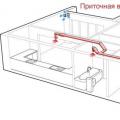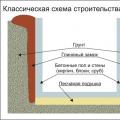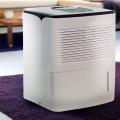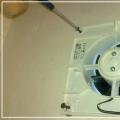Bathroom ventilation devices or the so-called forced exhaust are a very useful technique for your home. Installing a fan in the bathroom will allow you to get rid of excess moisture in the room, nullifying the process of condensation in winter or even in summer if the natural exhaust does not work. Renewal of air masses will help to avoid the accumulation of odors, eliminate the development of mold fungus on the wallpaper or the seams of the finishing tiles. But first, you should pay a little more attention to the types of devices and learn how to mount and fix the fan in the bathroom.
Types of fans and their features
Bathroom fans
Connecting a fan in the bathroom begins with the choice of device. Strange as it may seem, but the exhaust structures for the bathroom do not differ in great variety, therefore all types can be divided in just two ways:
- difference in diameter. This quality is responsible for the ability of the device to quickly remove moisture and odors from the room. And you need to understand that the larger the diameter, the faster the air mass in the room will be updated. But on the other hand, the more often the air flows begin to be updated, the faster the temperature in the bathroom will drop, because even the polluted, but heated air is removed. Therefore, excessive performance in this case can become not only the cause of colds, but also incur an overrun of the thermal energy carrier.
Advice! You can determine the optimal performance based on established standards: a size multiple of 20 mm is considered optimal. If you measure the ventilation opening in advance and purchase the right device, installing a fan in the bathroom will be much easier and easier. By the way, the largest diameter is 200mm, and the smallest is 20mm.
- The presence of additional sensors and functions is another parameter by which all bathroom fans can be divided. Valve, blinds, timer, switch, temperature sensor, clock - there can be many functions, you should understand if you need them. For example, a fan with a valve or shutters is good for an apartment building: after the end of work, the valve closes and prevents air from entering the apartment from the shaft. But sometimes the blinds need to be closed manually, but there are models with automatic blinds, where human intervention is not required at all. The device with a timer and a humidity sensor will turn itself on / off when necessary.
Advice! A fan with a switch is not a very convenient thing. You often have to climb a ladder to reach the switch cord. Therefore, if there are small children in the house, installing an exhaust fan in the bathroom (having a remote switch) is not recommended.
Now that everything has become clear with the types of appliances, it's time to think about how to install a fan in the bathroom.
Installation and connection
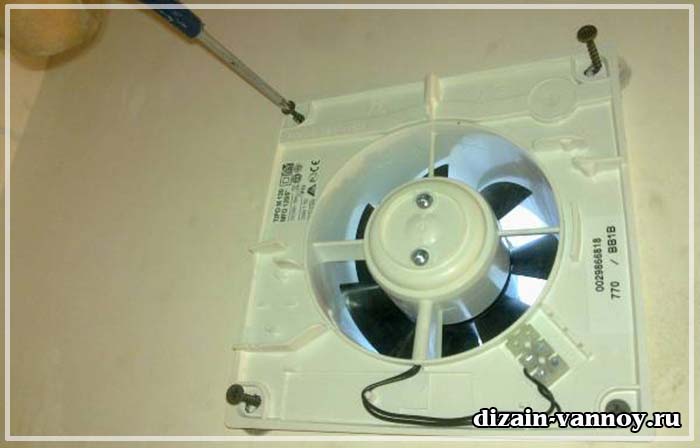
The wiring diagram for a bathroom fan is not as complicated as it might seem at first glance. A little skill and a home master will be able to cope with the work. Of course, if you want to know how to connect a fan in the bathroom and bring the wires to the apartment wiring, then you need to understand that there can be only two options: the device works together with lighting or standalone.
To connect the structure to the lighting, you need to parallel it with any lighting device (even a sconce in the bathroom), but if you plan to install a fan in the bathroom with the function allocated to a separate key, you will have to assemble a separate branch of the electrical wiring.
Advice! When the wiring is already completely done, and you don’t want to ditch the walls at all, take the phase for the fan from the light switch. It is necessary to separate the phase using a double switch, and "zero" in the junction box, which is located closest. Yes, you will have to gouge a strobe from the switch button to the ceiling space, but only one! But all the other wires and cables will hide in the ceiling panel or under the hanging trim.
If the appliance is already at home, then it is important to know how to remove the fan in the bathroom. Often it depends on who installed the fan in the bathroom or bathroom, but the overall picture is still the same:
- de-energize the device;
- unscrew the cover;
- disconnect the wires from the power terminals;
- unscrew the holding screws;
- remove the fan from the shaft opening.
If the device is not screwed, but glued around the entire perimeter of the plate, you will have to carefully break out the case using a screwdriver and a hammer. You can remove the structure along with the lining, if you also change it. It is only important not to expand the opening of the ventilation shaft, too large then you will have to close up or install a device with a large diameter.
And now the main thing: how to install a fan in the bathroom and connect
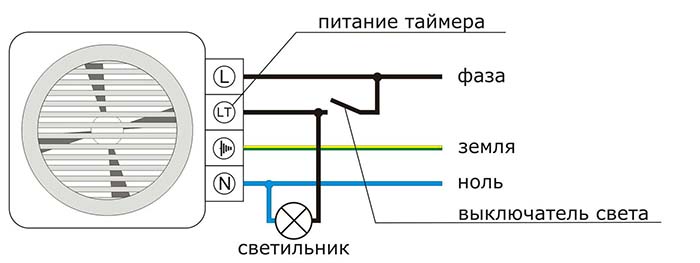
- Remove the cover from the device. The decorative panel is attached to a small bolt or opens from the side by pressing a screwdriver;
- Under the cover there is one pair of terminals with wires;
- Unscrewing the terminal screws, you then need to connect the wires already connected to the ventilation duct.
That's all. The device is connected, now you need to check its operation and enjoy clean air.
How to put a fan in the bathroom
- You can use the mounts offered by the manufacturer. But this often requires drilling holes in the wall cladding, which is not very convenient.
- You can come up with something of your own. For example, the usual mounting method using white silicone. But you need to figure out how to keep the device in place for half an hour. Usually craftsmen use standard tape.
Advice! If tiles are laid in the bathroom up to the ceiling and you don’t want to make holes in it to fix the fan in the duct, you can glue the device! To do this, smear the back of the panel with glue, insert the fan into the hole in the shaft, press it for 10 seconds and tear it off. Wait a minute, insert the device into the hole again and now press firmly. Now you know how to fix a fan in a bathroom where there is tiling throughout the entire area of the wall panels. You can watch the installation video below.
Adjusting the bathroom fan is not difficult: if there is a speed switch, then set the desired number of revolutions once and no more of your intervention is required. In the case when there is no switch, the device will work at the set power all the time while it is turned on.
Of course, installing a duct fan, like a radial fan, is not much different. Anyway, installing a forced ventilation device in a bathroom, basement or attic has a lot in common, the main thing is to choose a place where to install the structure and then connect all the wires correctly. But if you tried once, then no difficulties are expected in the future. If the batteries (wires) for the device have not yet been connected to the ventilation duct, take a wire with a cross section of 0.75-1.5 squares - this is the best option.
Advice! If you do not know how to handle electricity at all, do not worry. On sale a huge number of fans powered by batteries and batteries. Such devices absolutely do not require any skills during installation and can be placed anywhere and how you want.

